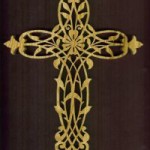Can You See Me? is an article that was originally posted on the Southern California Nevada Conference UCC Webpage. The author, Rachel Chapman, is a present board member of the United Church of Christ’s Disabilities Ministries. Rachel Chapman’s biography can be viewed on our Board of Director’s page.
Upon entering the sanctuary I head toward the narrow space between the steps to the dais and the wooden divider in front of the first pew. It’s a tight fit but I do it. As the portable microphone is brought down and put in place for my message, someone says they expected me to take the ramp up to the dais so I “could be seen…”
I didn’t because I had a plan. My message for the evening’s service was to raise awareness of being Accessible to All. It began:
“Most of you know I can stand and even walk, although I admit it’s not always very graceful. I am opting to give the message from my scooter, not because I’m tired or because it’s convenient. I am making a point that when I’m on my scooter, some people do not see me. Notice I did not say they can’tsee me. I’ve come to realize that when I am on my scooter, some people do not see me, consciously or subconsciously. People choose to look past me, partly because they do not look down and/or they look at me then look away. Seeing people who are different from us sometimes takes us out of our comfort zone, but seeing people who are differently abled, physically or mentally, tends to really make us uncomfortable. Why do you think that is? It’s an attitude.
“Martin Luther King, Jr. said the 11:00 hour on Sunday morning is the most segregated hour in America. I believe that, but I also believe it is the most alienating hour. Whether brown, black, yellow or white; whether church, temple, synagogue or sports stadium, people who are differently abled are seldom made to feel welcome. Studies show the percentage of people who describe themselves as having a disability and who attend church at least once per month is significantly lower than the general population. Now as the likelihood of attending church increases as one ages, just as the likelihood of developing a disability increases, you would expect that the number of congregants with disabilities would be greater than the general population, not smaller.
“A few years ago the Harris Interactive survey determined that people with disabilities (of any severity) are not just significantly less likely to attend worship services but are 35% more likely tonever to attend a worship service because they are less likely to feel welcome or comfortable in houses of worship. I know that some of you are thinking ‘we’re welcoming…we have a ramp and accessible parking spaces’ and that’s great BUT there is so much more. It’s about attitude!”
One of the UCC tag lines is “Jesus didn’t reject people, and neither do we.” It was developed for the LGBT community but I believe it’s fitting for everyone. In Mark 5, we learn that Jesus did not reject the woman with the issue of the blood. And in Luke 5 when the man with leprosy came to Him, he was not rejected; or when the faith of friends brought the man who could not walk and lowered him through the roof, Jesus did not reject him either. The man who lived in the tombs, possessed by demons…mental illness in today’s world, was also not rejected. So, how can WE, the church, reject those who are different?
Look around you. Whether we admit it or not, everybody struggles with something! We are charged in 1 Peter 5 verses 9-10 to ‘offer hospitality to one another without grumbling. Each one should use whatever gift he has received to serve others, faithfully administering God’s grace in its various forms.’ Our churches will find themselves abundantly blessed by the gifts differently abled persons have to offer, if we just change our attitude!
So what can we do to be more accessible to all? The UCC Disabilities Ministries Board is in the process of developing a guide to help churches become accessible. We must start by removing all barriers that keepanyone from fully participating in the life of the church by adopting an attitude of inclusion.
First, recognize that not all disabilities are physical. Also recognize that Lord willing, we will all live to an old age but that aging process may not always be kind.
Have patience with the child with attention deficit disorder who can’t sit still during service. Show compassion toward the mom who is doing her best. Rethink how to approach the veteran who seems standoffish but in fact may be suffering from PTSD and is uncomfortable with others in his or her space. Acknowledge with a smile the person sitting next to you. He or she may have an unshared diagnosis of depression and needs one small glimmer of hope to keep from jumping off the bridge on the way home.
Be sure to face people when speaking to them, including coming down to their level by pulling up a chair if talking to a person in a wheelchair or scooter. Always speak directly to the person, not just to their companion. Stress the person, not the disability, such as saying, “she’s a woman who is blind” rather than a “blind woman.” And always ask before assisting someone.
Let’s change our attitude from rejection to inclusion and from inaccessible to accessible. More guidelines to the process of becoming accessible to all are available. I will be happy to talk with those interested in learning about them.
My message ended with Romans 12 verses 12-13:
“Be joyful in hope, patient in affliction, faithful in prayer. Share with God’s people who are in need. Practice hospitality.”


